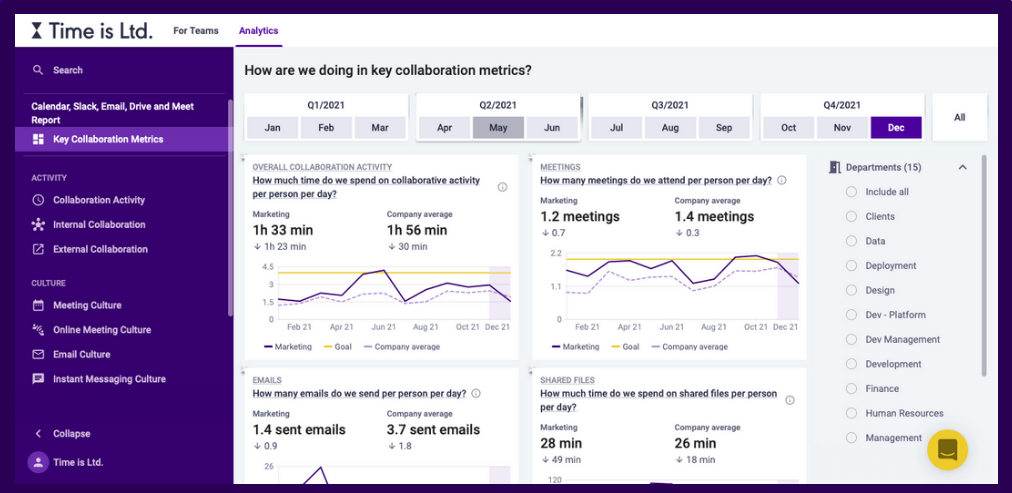Your PPM can analyse portfolio costs and progress, but it can’t monitor one of the biggest causes of failure: poor communication. Or can it?
It’s accepted that projects, products and change programmes come with a risk of failure. In some cases, that risk can be significant: the Project Management Institute’s 2021 Pulse of the Profession report found:
- 11-13% of projects were deemed failures
- 36-37% of projects failed, and the budget was lost
- 33-37% of projects saw scope creep
- 9-10.5% of investment was wasted due to poor project performance
You likely already have a project portfolio management (PPM) or SPM solution to help you monitor and manage financials to reduce that risk. But budgets and deadlines are arguably only one risk factor in modern projects.
This blog explores the vital importance of collaboration and communication in driving success. It will investigate why collaboration is so important, the stark impacts of poor communications and how new collaboration analytics solutions can integrate with SPM & PPM tools to reduce risk across your portfolio.
Change programmes have a communication problem
In one of its older industry reports, the Project Management Institute suggested that for every $1B spent on projects, $135M was at risk. And 56% of that at-risk capital is in jeopardy due to ineffective communications. Indeed, authors and project experts William Dow and Bruce Taylor go further in claiming that “90% of project failure is down to “communication problems”. Certainly, our experience tells us that poor communication sits at the heart of pretty much every failed programme”.
While these figures are old (2013), there’s nothing to suggest this problem has eased over the years. Quite the opposite in fact. A PMI report from just a few years ago still found that 29% of failed projects fell short due to inadequate communication. This only gets worse as team sizes grow and programmes become more complex – a trend we’re seeing across many sectors.
And as enterprises settle into a new normal built on hybrid working, they must also contend with the challenges of a geographically fragmented workforce. With 70% of remote employees claiming they feel left out of the workplace and 57% reporting they missed out on important information because they work remotely, it’s clear that communication is only becoming more complex, and more of a risk factor in project success.
While today’s most advanced SPM suites can offer unparalleled insight into the progress and performance of your change management programmes, they can’t necessarily bring the communication insights you need to avoid this common fault point. Or can they?
Bring clarity to communication with collaboration analytics
Just as your SPM can drill down into financial data to understand the state of a change programme, a new category of analytics tools that can analyse your communications tools to explore how well teams are collaborating is opening up new avenues to optimise project performance.
Time is Ltd. is one such platform that can help project owners understand the state of collaboration across all communication tools. It analyses calendar metadata, examines sociomapping information and explores communication frequency across platforms to understand who’s talking with who, and whether they’re communicating in an effective way.

Combine SPM and collaboration insights to minimise risk
By combining the insights from a collaboration analytics tool and the data you collect in your PPM solution, you can get a comprehensive view of how a new project or change programme is progressing.
In fact, bringing collaboration data into the mix helps you do three powerful things that minimise risk:
1. See previously unseen (but crucial) data points
By sociomapping communications lines within and across departments, you can see a previously hidden but vital metric for change programme success.
For example, if you can see the IT team has little interaction with other departments over the course of your digital transformation programme, that could be an early warning sign that collaboration is poor – and potentially putting your programmes at risk. If your stakeholders are complaining they feel disengaged you can see whether they are right.
It can also help establish patterns of success. If you see certain teams are always communicating frequently across your most successful change programmes, that could help you build future collaboration models to improve future efforts.
2. Minimise overload to maximise engagement
As we rely on more communications channels, the overload can actually harm rather than help collaboration. A recent report on the digital workplace found just over half of employees were overwhelmed by non-work chat messages.
With a comprehensive solution like Time is Ltd., you can identify frequent sources of information overload across all your communications tools.
This can help you identify how to streamline collaboration toolsets to reduce overload, boost engagement and optimise the way teams communicate across your portfolio.
3. Make meetings more productive
Recent figures suggest up to 24 billion hours are wasted each year due to unproductive meetings. Collaboration analytics tools offer a targeted way to reduce the time spent in unhelpful meetings and improve overall productivity.
Advanced solutions like Time is Ltd. can help organisations find the meeting sweet spot where teams collaborate and communicate effectively, while staying efficient and saving valuable time.
Better collaboration leads to better outcomes
By combining SPM and collaboration analytics, organisations can shine a light on previously invisible yet vital signifiers of progress. By bringing all these insights together, product and programme leaders can better understand where things go wrong, how to get communication back on track and how to improve collaboration across future products and programmes.
Bringing collaboration and SPM data together isn’t always straightforward, but the right partner can help you integrate datasets in a way that sets up your business – and your portfolio – for success.
Get in touch to learn more about how we can help you combine collaboration and SPM insights.




